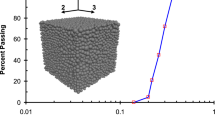Conclusions
-
1.
The dependence of effective viscosity on shear rate for a melt of composites with a granular (particulate) filler or short fibers can be reliably reduced to the analogous dependence for a melt of the matrix by means of two linear coordinate transformations if one of them (along the η axis) is determined by the Mooney formula.
-
2.
When a melt of a composite with a hybrid filler is regarded as a melt with a single homogeneous filler whose matrix is the polymer filled with the second component, theoretical relations are obtained that satisfactorily describe the flow curves of melts of composites with a hybrid filler.
-
3.
The effect of the composition of the hybrid filler on the viscosity of the composite melt is greater, the higher the filler content. This effect changes little with shear rate.
-
4.
Values of the Einstein coefficient calculated from test results for a melt filled with long fibers (ℓ/d ≈ 250) are considerably lower than the values obtained by extrapolation of established relations for short fibers.
Similar content being viewed by others
Literature cited
G. V. Vinogradov and A. Ya. Malkin, Rheology of Polymers [in Russian], Moscow (1977).
Yu. S. Lipatov, Physical Chemistry of Filled Polymers [in Russian], Moscow (1977).
G. V. Vinogradov, A. Ya. Malkin, N. V. Prozorovskaya, and V. A. Kargin, “Rheology of polymers. Universality of a temperature-invariant characteristic of the viscosity of polymers in the condensed state,” Dokl. Akad. Nauk SSSR,154, 890–893 (1964).
L. A. Faitel'son and E. E. Yakobson, “Rheology of filled polymers. Steady shear flow and periodic deformation,” Mekh. Polim., No. 6, 1076–1083 (1977).
P. Geisbusch, “Ansatze zur Schwingungsberechnung ungefullter und mineracisch Gefullter Thermoplaste,” Diss. der RWTH, Aachen (1980).
M. Mooney, “The viscosity of a concentrated suspension of spherical particles,” J. Colloid Sci.,6, 162–170 (1951).
I. P. Briedis and L. A. Faitel'son, “Rheology and molecular structure of melts of polyethylenes. Identification of melts with respect to mechanical properties,” Mekh. Polim., No. 3, 523–532 (1975).
V. A. Ivanov, V. V. Moshev, and A. E. Marchenko, “Rheological behavior of concentrated polydisperse suspensions with a non-Newtonian dispersion medium,” III All-Union Symposium “Theory of the Mechanical Processing of Polymers,” Perm' (1985), p. 71.
J. M. Burgers, Second Report on Viscosity and Plasticity, Nordemann, New York (1938), p. 113.
L. Nielsen, Mechanical Properties of Polymers and Polymer Composites [Russian translation], Moscow (1978).
Author information
Authors and Affiliations
Additional information
Translated from Mekhanika Kompozitnykh Materialov, No. 2, pp. 219–224, March–April, 1990.
Rights and permissions
About this article
Cite this article
Briedis, I.P., Teteris, G.G. Predicting the non-newtonian viscosity of a melt of a polymer composite with a hybrid filler. Mech Compos Mater 26, 171–176 (1990). https://doi.org/10.1007/BF00612315
Received:
Issue Date:
DOI: https://doi.org/10.1007/BF00612315




